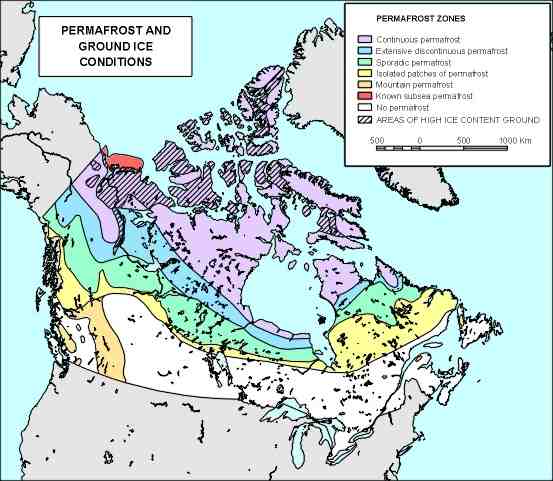Permafrost is defined as soil that maintains a temperature at or below freezing for two complete summers and an intervening winter. Actual “frost” doesn’t need to be present. Also the extent of permafrost in the Northern Hemisphere varies dramatically. It depends on many factors including topography, seasonal weather patterns, and permanent climate change.
There are also different ways to categorize permafrost depending on coverage and extent: continuous, discontinuous, sporadic and isolated. Thus it’s a bit of a misnomer to tag any spot as the southernmost point of permafrost in the hemisphere. The answer constantly changes. That won’t stop me from offering broad, sweeping generalizations, though.
I will focus solely on the northern hemisphere. Obviously there’s lots of permafrost down under too. However, the boundary falls primarily within the Southern Ocean and it’s not nearly as exciting as a boundary crossing nations. I will try to find something equally fascinating for our readers from New Zealand and Australia in a future article (suggestions appreciated!). Nonetheless I’ll remain north of the equator today.
Two countries — vastly apart both culturally and geographically — lay claim to the distinction: Mongolia and Canada. I don’t think either country is wrong in their assertion but it depends on how one chooses to describe “permafrost.”
Mongolia
Everyone says “the southernmost limit of permafrost in the Northern Hemisphere is in Erdenetsogt Sum of Bayan-Hongor Aimag, at 46°17′ north latitude near the Daragt Mountain.”
Mongolia is divided into 21 Aimags. Those, in turn, are subdivided into 315 Sums in case you were wondering. I wondered the same thing before I looked it up. Now I have to figure out how to work that into a conversation with people who won’t care anyway.
Of course all of these websites simply copy from one another in a circular manner. Unfortunately that makes it impossible to track it down to a verifiable source. The best semi-official government page I could find was the Mongolian Embassy in Moscow [link no longer works] so I guess that will have to do. Should I have faith in this assertion? I’m not sure I’m totally there yet. However, the location would be right around here:
For some reason the rest of the quote also mentions that Mongolia has the world’s northernmost desert at Buurug Deliin Els. That makes the shortest distance between desert and permafrost anywhere in the world about 770 km (440 mi).
I don’t know about the first part, but the shortest distance is bogus. Antarctica is a desert. So there’s at least one huge area where the distance between desert and permafrost is the depth of the snowpack. Maybe they’re thinking a desert has to have sand and camels.
Canada
For this section I got to use one of my favorite websites, the Natural Resources Canada / Geological Survey of Canada site. Specifically I referenced “Permafrost. Where Does it Occur?” Well, in Canada as it turns out, in more places than not. Seriously, “Permafrost underlies more than 50% of the ground surface of Canada.” Impressive. Without a doubt Canadians know something about permafrost.
The Kenora District is part of northwestern Ontario. It contains a strip of land along the southern shore of Hudson Bay that is continuous permafrost and true Arctic tundra . This is included as part of the lavender band on the map below. Thus it extends as far south as 54° N, and represents the southernmost extreme within the circumpolar band of continuous permafrost anywhere on earth.

Mongolia claims permafrost at 46°17′ N and Canada claims 54° N. Mongolia wins, right? Not so fast. Take a look at this “Circum-Arctic Map of Permafrost and Ground Ice Conditions“. I’d reproduce it here but it doesn’t fit well on the page, so go ahead and open it in a different tab or window.
It’s a bit difficult to see but Lake Baikal is fairly visible and Mongolia would be south of that. The whole multi-colored patch around the general area of Mongolia appears to designate either sporadic or discontinuous permafrost.
That gives both countries an ability to make a legitimate claim. Canada certainly has the southernmost continuous permafrost, and Mongolia seems to have as much of a right to say they have the southernmost permafrost — albeit not continuous — as any of the northern tier countries. That’s today. It could be something else entirely tomorrow.

Leave a Reply